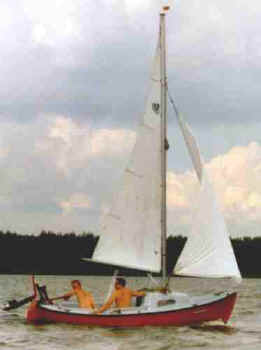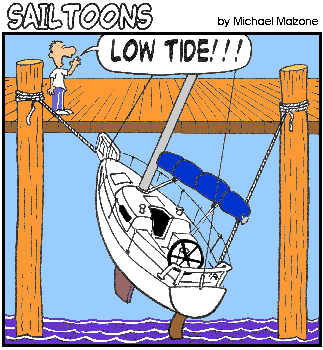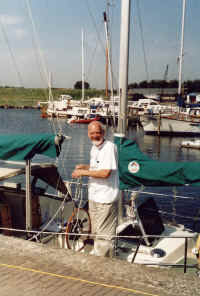
Een club voor liefhebbers en/of bezitters van een zeiljacht van het Oostzeejol type Midget.

|
A week of "England"
Midgetsong 1998
Affliction or virus
German Sands
|
 INFORMATION
ABOUT THE MIDGETCLUB,
INFORMATION
ABOUT THE MIDGETCLUB,
Club for lovers and/or owners of a sailing yacht of the type “Oostzeejol”.
Founded in October of 1977, the first meeting was on January 27, 1978 in De Lier, Zuid-Holland and the first “wet” reunion was held on the Haringvliet in the weekend of Saturday and Sunday July 22 and 23, 1978.
The purpose of the Midgetclub is stimulating contact between owners and/or lovers of a sailing yacht of the type “Oostzee-kruiser” (Baltic cruiser). In the even years members organize a “wet” reunion on the waterways of the province of Zeeland. In the odd years this is done on the IJsselmeer. During the course of a week members sail together and visit a different port each evening.
The Midget Oostzee-kruiser has the classic form of the Baltic sloop as it was built in the early 1800s in the area of Lynaes, Denmark. The form of the hull can be found in the small 13 foot rowing/sailing dingy as well as in the heavy 50 ton Kattegatt fishing cutters.
The Midget Oostzeekruisers exist in several sizes: 13’, 15’, 20’, 25’, 26’, 29’ and 31’. But only the 20’, the 26’ and the 31’ are actually called “Midget”. However, they and all the other sizes are of the “Oostzeekruiser” type.
Four times a year the club publishes a newsletter under the name “ ’t Spitsgattertje” (in the Dutch language only) and 3x a year the members meet in the restaurant “Kraaiennest” located in the picturesque village of Kortenhoef near Hilversum. The number of members is around 240 at present, of which some ten are foreign members.
Membership is open to lovers and/or owners. Therefore even if you do not (yet) own a Midget, you are welcome in the Midgetclub. Dues are €uro 20.00 for members in The Netherlands, for those living abroad dues are €uro 25.00 a year (in 2013). (Dues are outside Europe (not Euro country's) €uro 25.00 a year )
In nearly every yacht harbour in The Netherlands one can find one or more Midgets. The sturdy canoe-ender with its typical Scandinavian shape – also named “Oostzeejol” – was originally built in 13, 15 and 20 foot sizes. The larger 26 and 31- footers are still in production. Midget sailors are lovers of its character: the Midget Club is one of the more successful boat-type clubs of The Netherlands.
Just like all “classics” the Midget has a group of loyal fans, sailors who like her as much to look at as to sail in her. When you sail together you can combine both pleasures (plus some more) and therefore Midget sailors like to rally annually for a week. In the even years they collect on the waters of Zeeland, in the odd years they go to the IJsselmeer. The fleet consists normally of some 20 to 30 Midgets of different sizes. The tradition of collective sailing trips has by now reached the age of 28 years, nearly as long as the Midget Club is old.
|
Founder of the club is Leendert W. Koppenol from Klijndijk, who is still the President. Koppenol: “It is a real heavy-weather model: no typical fast runner, but built for rough seas. This is visible in every detail. Midget sailors are all keen on their vessel. I know members who regularly make a trip to England in their 20 footer”. An active club is the best proof of the popularity of the Midget among its users. A number of them have arranged for a design of the successor to the 20 footer. That became the 26 footer, which was later followed by the 31 footer. Both “super-Midgets” are still launched at De Kloet in Kortenhoef and have become as great successes as their older sisters. Especially in Germany one sees them frequently, but also in the French Mediterranean and even in Japan they sail about. Thanks Janet Nuboer, from Boston USA, for the translation. |
|
Reunion 2003 “Around the North”
About 400 years ago the Dutch started to make extensive journeys to Asia. All media and musea have given this fact comprehensive coverage during this, the Anniversary Year. The Dutch went out there themselves to buy pepper and other valuable spices. This way they would no longer be dependent on the Spanish and Portugese traders for this expensive merchandise.
In the first instance an alternate route was sought via the North, in order to reach Asia around the north of Russia. Captain Willem Barentsz , however together with a crew of fourteen stubborn sailors remained stuck in the ice on Nova Zembla. Following this misadventure they sailed to Asia via the Cape of Good Hope. With the United East Indian Company (VOC) Holland had launched the world’s first multi-national, thereby dominating a large section of world trade.
Next year we are going around the North also, but will follow Willem Barentsz only part of the way.
We will meet on Monday afternoon July 28 in an old VOC harbour, where 400 years ago the ships parted for India (Waypoint N52 42’15’’ E5 17’90”)
On Tuesday we will sail to a true Dutch Ysselmeer town. (Wpt. N52 46’20” E5 6’90”)
From afar we will see the tower of the dungeon/castle, built by Count Floris V 800 years ago in order to subjugate the population.
On Wednesday we will head for a peninsula that was still an island 100 years ago. The son of the German emperor had been banished there. (Wpt. N52 55’20” E5 3’00”)
The next day, in spite of ice and weather, we will sail to the archorage below an island, where once upon a time the ships from the cities of Holland would gather to head out to the East together. We suggest that it would be more restful to aim for the harbour rather than to stay bobbing in the bay. (Wpt.N53 2’45” E4 51’25”)
The last port that’ll be our destination on Friday will definitely be a secure harbour. We will be right next to our navy. We can safely leave our boats there while we go for our closing dinner. (Wpt.52 57’60” E4 47’50”)
The reunion committee is well aware of the fact that the various waypoints also have conventional names. After all, we have made ourselves clear enough for the sailors, but for the passengers it might be fun if we were to also mention those names. We’ll do some research. We hope to have found those names and will publish them before the next edition of this publication makes its appearance.

Gathered Information
This information has been collected and re-printed here from various sources.
*
Halman 21
Trailer-sailing with a North Sea Flavour by Lloyd Hircock
*
Owner's
Review for the 1980 Halman 20 Nordic by Colin Starratt
*
Other
Halmans / Nordica's
*
Owner's
Review for the 1975 Nordica 16 by Wim Kreeft
*
Owner's
Review for the 1976 Nordica 16 by Nick Adams
*
Owner's
Review for the 1982 Nordica 30 by Darius Peleda
*
Owner's
Review for the 1983 Nordica 30 by G. Aerts
Halman 21 Trailer-sailing with a North Sea Flavour
By Lloyd Hircock
One of the first boats I considered buying during my search for the perfect ""starter"" many sailing years ago was the traditional ""North Sea Double-Ender,"" a design similar to the Halman 21. To me, it possessed the quintessential qualities necessary for the perfect offshore vessel - transom-hung steering, long keel, curving sheer, an almost plumb entry, and powerfully built. A stout and hardy vessel to be sure; the right vessel to carry me unscathed to the destination of my choice. But I didn't buy her and unfortunately I never got to sail the yacht. On a lazy August day, 15 years later, I renewed an old acquaintance and finally test-sailed such a design.
The Halman 21 is built by the Halman Manufacturing Co. in Beamsville, Ontario. Purchased by Richard Navin in 1978, the company also manufactures the famous 24-foot Shark, the Halman Niagara 26, the Bluejacket 23 Motorsailor, the Henley 20, and the Horizon 31 cutter in its 8,000-square-foot facility. The plant consists of a complete cabinetry and paint shop and enough floor space to lay-up three designs simultaneously. "We're small," says Navin, the hands-on owner, "but I believe that's good for our customers. We can service everything we manufacture - and if there are warranty problems I personally get involved for the duration."
While not exactly a household brand name, the Halman 21 has attracted a following. Either you like the traditional design or you don't &&emdash; there's no middle ground. New owner Murray Belisario purchased a Halman 21 in the spring of 1989. "It was our first sailboat," the enthusiastic owner told me. "My wife and I saw the yacht sitting outside Richard's place and bought it - that simple. I had seen the Nordica (a similar design) before, and liked the lines." And reports from owners indicate one of the benefits of owning a traditional vessel is the buoyancy of the resale market.
The boat was introduced in 1977 as the Halman 20, and its reincarnation as the Halman 21 four years ago provides an interesting perspective on the boating market. A U.S. dealer "who thought we should dress the boat up", according to Navin, placed a custom order for a 20 with a bowsprit and increased sail area to enhance sailing ability in light air. He also wanted a higher standard of finish, which included bronze port lights and halyards led back to the cockpit. Navin was tentative ("I was really reluctant to put the bowsprit on, because it might affect sailing performance") but he agreed, and the result was a revelation. The more upmarket version, dubbed the Halman 21, was an immediate success. At a time when builders were trying to woo customers by building cheaper boats, Halman scored by building a more expensive one. "The moment we sold a 21," he says, "we never sold another 20."
The one-piece hull is manufactured using 4 1/2 oz. mat bonded with polyester resin to 24 oz. woven roving and 1 1/2 oz. mat throughout. Extra 24 oz. roving is employed below the waterline. The bilge and keel area is further strengthened using unidirectional glass, stem to stern. The deck is reinforced with a core of endgrain balsa sheets.
The roomy cockpit is deep with high moulded coamings surrounding the perimeter. Wide, flat side decks make the journey to the mast and bow area easy and safe. All deck hardware is first class. Here the builder has gone all out, installing bronze ports, winches and cleats throughout. Controls lead aft and are rigged outside cockpit seating space - away from the traffic flow.
The cabin interior is appointed with teak solids and veneers. A white vinyl headliner and moulded pan serve to accentuate the darker wood tones of the strip paneling fastened to the hull walls. Headroom is a modest five feet, enabling comfortable sitting. Ventilation is adequate. With six opening ports and the cabin hatch cracked a decent cross draft is achieved. One of my pet peeves is lack of sufficient ventilation. Thankfully the Halman 21 is well vented and should prove to be airy, even during those heavy sultry days.
Sleeping accommodations are understandably limited for a boat this size, but the design will serve well as a weekender. In keeping to scale a small galley has been fitted to port.
Standard equipment includes an icebox, single sink and plenty
of storage space for utensils above and below the galley area. A fitted
recirculating head is stationed in the V-berth. The deck-stepped single-spreader
masthead rig employs twin lowers fore and aft, and a 7/8 upper.
The mainsail is large for a masthead design, but with a 2,500-pound payload
perched on a 21-foot frame with a long keel, the vessel requires all the power
the 220 square feet of sail can generate to maintain speed.
Unfortunately, as with the Precision 23, I picked a calm day for the test-sail.
The wind was a no-show. Although the air filled in every few minutes it was a
teaser with never any great velocity above 5 knots. Nevertheless we sailed
smartly onto a close reach with good burst of speed.
Owner
reports indicate the yacht sails well in a freshening breeze and paces well to
weather. Certainly, when sailing off the wind the yacht should track exceedingly
well. I found the yacht well founded and a comfortable sailing vessel.
To contend with dead calms or uncooperative zephyrs, buyers have the option of ordering a 9-hp Yanmar IGM diesel. Historically Navin says only about two percent of customers have opted for the diesel, although in recent years that proportion has risen to about ten percent as the boat has attracted a more affluent buyer looking for a mini-motorsailer. The boat otherwise only requires a 6-hp outboard for auxiliary power, but Navin recommends a 7.5 or 8-hp model to get electric start.
The design makes trailering a snap. The long keel, modest draft and moderate beam positions it well on most single or double axle trailers with a 3,000-pound load capacity. While the Halman 21 is not everyone's cup of tea, the relative security of design and proven sailing ability, especially in a heavy seaway, will appeal to first-time sailors with small children who enjoy wandering down the asphalt highways in search of more challenging sailing venues. It will also appeal to veteran sailors desiring a strong, compact sailboat up to the challenge of stiff breezes. The price is also right, with a fairly completely equipped boat (including sails, but less engine and trailer) listed at $20,900. I probably should have bought one.
Specifications
Owner's Review for the 1980 Halman 20 Nordic by Colin Starratt de622@freenet.carleton.ca
This review is reprinted from Sailnet's Boatcheck http://www.sailnet.com/boatcheck/
Double-end North Sea design with full keel and cut-away
forefoot; large attached rudder and tiller; 2 sets lower shrouds with masthead
single-spreader rigging on a cabin-top stepped mast (mast base can be adjusted
to affect weather helm); internal halyards on mast and boom; jiffy-reefing (3
sets points on mainsail, 1 on working jib); inside ballast; displacement 2500
lbs.; storage in cockpit lazarette and under pilot berths, V-berth and sink.
Toilet under V-berth as well as water and sewage tanks. Very stable boat with
large cabin and small cockpit (4 people) with bridge deck; tracks well, but
tacks slowly and only fair windward and light-air performance due to keel and
wetted surface; Performs well in a blow, but pounds a bit when driven into waves,
especially when motoring; outboard-powered (long-shaft required). Trailers well,
but needs a substantial vehicle for long distances. This is a cruising boat
rather than a racing boat ... good for beginners: easy to sail and very
forgiving; will self-tend on points of sail forward of the beam with sails
trimmed and the tiller lashed. Self-righting when tiller released when knocked
down (been there, done that). Will do 6 knots in a stiff breeze, but likes 5
knots better; light air performance can be improved by raising outboard prop out
of water. Accommodates genoa and cruising spinnaker, and storm dodger as well,
(This review appears to have been truncated on Sailnet's site. Bummer.)
Owner's Review for the 1975 Nordica 16 by Wim Kreeft Wim Kreeft [wim.kreeft@ns.sympatico.ca]
"The Nordica 16 is a stable, sea worthy boat that sails as if it is a much larger boat. It handles heavy weather very well. It's roller reefing main allows it to be sailed in some of the heaviest winds. The cuddy cabin is appropriate for storage, but sleeping would be difficult. It 20 inch draft allows it to go most places. It is ideal for snooping around the various coves and inlets on the Bras d'Or Lakes. We are extremely pleased with the boat! "
Owner's Review for the 1976 Nordica 16 by Nick Adams Nick Adams [greekgod@mail.netrover.com]
Design: Salty full keel, double-ender. Cuddy cabin with two
6'8" berths. Displacement - 925lbs, Beam - 6'2". Concrete ballast
enclosed in fiberglass.
Strengths: Very stable and kind motion in heavy seas. Can handle heavy weather.
Does not heel very much - don't waste money on a sailor's clinometer. A very
pretty design. Fast in high winds. Easy to load/unload from a trailer due to its
shallow draft (1'10").
Weaknesses: Cockpit is not self-draining - this is annoying. Slow in light winds
- a No 2 Genoa sail helps. Overall Satisfaction: Very
high.
Owner's Review for the 1982 Nordica 30 by Darius Peleda
Darius Peleda [dpeleda@rfcuny.org]
Double ender, uniquely designed by B. Malta Mueller, beautiful and very functional; rugged and well balanced. Built by EXE FIBERCRAFT of Exeter, Ontario. Sloppy workmanship, choice of hardware and finishing touches could be better.
Owner's Review for the 1983 Nordica 30 by G. Aerts G. Aerts [xrickme@ssimicro.com]
A double ended, masthead sloop with full keel/cutaway forefoot, the rudder is a stern hung tiller design. L.O.A. IS 29'10" with a L.W.L. of 25'10". The model I have has a factory-mounted bowsprit, which increases the L.O.A. to 33'. The interior is teak and the lay out is roomy...more so than most boats in this size category. Woodwork inside is not done to the best standards and is a common problem with all Nordica’’s. The layout incorporates a galley with propane oven, two sinks and a cooler/icebox. A dinette to port and a settee to starboard which incorporates a nav station. The vessel sleeps 4 in comfort and six in total. The layout and design of the vessel allows for lots of storage space. The head clearance of 6' is fine for me, but some of my taller friends find it a bit short. I currently sail on Great Slave Lake in the Northwest Territories. I find the boat to be reasonably quick for a moderate displacement hull and is downright fast off the wind. It has a very seakindly motion, is relatively dry even in high steep waves encountered here. Some modifications were done to allow access to all areas of the hull and as well to the factory scupper drains which are woefully too small to be of any use (1/2"). The factory supplied Volvo/17hp was replaced with a new 27hp Yanmar. All in all a very forgiving boat that handles very well.
|
Reaction from Canada: Sent: Wednesday, January 23, 2002 6:38 PM Subject: Halman
|
ADVICE ANYONE ?
12-02-2003
A question for the Midget Community.
Bert van Loen is asking for a solution to the following problem. Who’s got an answer?
De cabin of our 20’ Midget “Obelix” has had carpeting glued to its insides (walls and ceiling) by the previous owner. In the meantime this has become old and dirty. I have read Diederik Manche’s story about lining the cabin in wood, but that to me appears to be an enormous task. Who has had a successful experience doing the walls on the inside of the cabin? If so, which material, and how does if affect condensation? All suggestions and tricks are welcome
Thanks in anticipation of all suggestions.
Bert van Loen.
Answer of
John Cardoso Halman 20 “Fandango” New Brunswick,
Canada
12-02-2003
I compliment your Dutch friend for his/her courage to scrape that ugly stuff off the walls. That in itself is a Herculean operation; it took me days of scraping, in the most awkward positions, and of trying four different glue removers and other things in between like dw40 andacetone, none of which really worked well.
The only product that "kinda" helped was a Canadian product called Foam-Off. It
softened the old glue a bit but still a lot of scraping was needed. NOTE: A good
face mask MUST be used to filter those ugly fumes.After all that scraping, there
were still bits of glue left all over.
So I decided to take some advantage of that evil and use it to add some texture
on the interior walls of the cabin, and to add to that texture, and hide the
left over glue, I used Canadian Tire Rubberized beige spray paint - the kind you
use to undercoat your fenders.
That stuff is great; I have used it before to paint the inside of the lazarette
on my DS-16, which had the paint all cracked. Because it is so thick and
textured, the rubberized paint covers up a lot of sins.After a couple of coats
of that, I applied 3 coats of the best latex exterior paint I could find around
here.
I figured that if exterior latex can endure years on the exterior of a
houseexposed to sun, snow, slit and rain, it surely could do it on the interior
of the cabin. It looks great and I expect it to last a long time..
And
that's all folks.
wishing you
Fair Skyes -Gentle Seas- and a Soldiers Wind" for all of your days.
secretariaat
Midgetclub:
Langeveldstraat 19
7871 PJ Klijndijk
061 9392 600
Ons e-mail adres: midgetclub -at- home.nl ( -at- = @)
20' Midgets

15'
Oostzeejol
26' Midget

Informatie, organisatie en
secretariaat van de MidgetClub:
Corry & Dirk Broeckman
Boeier 02-57
8242 CE Leleystad
e-mail:
info@midgetclub.nl
Bankinformatie:
NL64 INGB 0006 5008 75 t.n.v. Stichting Midgetclub
Redactie clubboek 't
Spitsgattertje van de MidgetClub:
Thécla & Jos van Geelen & Ouwehand
Dorpsstraat 159
1534 NH Oost-Knollendam
e-mail:
redactie@midgetclub.nl





